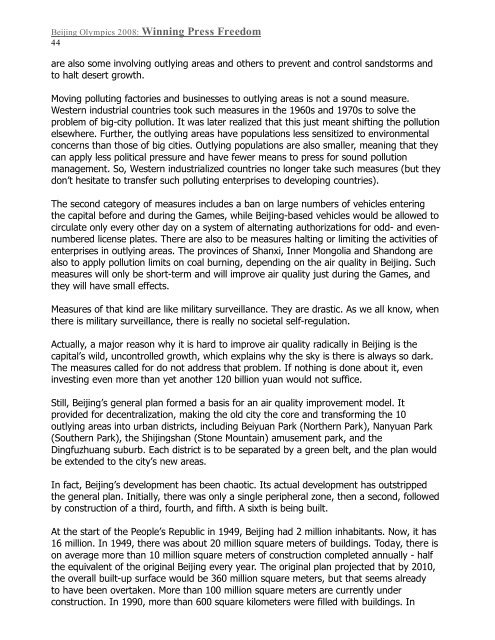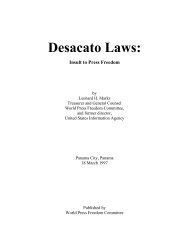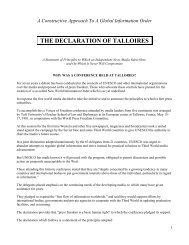Beijing Olympics 2008: Winning Press Freedom - World Press ...
Beijing Olympics 2008: Winning Press Freedom - World Press ...
Beijing Olympics 2008: Winning Press Freedom - World Press ...
You also want an ePaper? Increase the reach of your titles
YUMPU automatically turns print PDFs into web optimized ePapers that Google loves.
<strong>Beijing</strong> <strong>Olympics</strong> <strong>2008</strong>: <strong>Winning</strong> <strong>Press</strong> <strong>Freedom</strong><br />
44<br />
are also some involving outlying areas and others to prevent and control sandstorms and<br />
to halt desert growth.<br />
Moving polluting factories and businesses to outlying areas is not a sound measure.<br />
Western industrial countries took such measures in the 1960s and 1970s to solve the<br />
problem of big-city pollution. It was later realized that this just meant shifting the pollution<br />
elsewhere. Further, the outlying areas have populations less sensitized to environmental<br />
concerns than those of big cities. Outlying populations are also smaller, meaning that they<br />
can apply less political pressure and have fewer means to press for sound pollution<br />
management. So, Western industrialized countries no longer take such measures (but they<br />
don’t hesitate to transfer such polluting enterprises to developing countries).<br />
The second category of measures includes a ban on large numbers of vehicles entering<br />
the capital before and during the Games, while <strong>Beijing</strong>-based vehicles would be allowed to<br />
circulate only every other day on a system of alternating authorizations for odd- and evennumbered<br />
license plates. There are also to be measures halting or limiting the activities of<br />
enterprises in outlying areas. The provinces of Shanxi, Inner Mongolia and Shandong are<br />
also to apply pollution limits on coal burning, depending on the air quality in <strong>Beijing</strong>. Such<br />
measures will only be short-term and will improve air quality just during the Games, and<br />
they will have small effects.<br />
Measures of that kind are like military surveillance. They are drastic. As we all know, when<br />
there is military surveillance, there is really no societal self-regulation.<br />
Actually, a major reason why it is hard to improve air quality radically in <strong>Beijing</strong> is the<br />
capital’s wild, uncontrolled growth, which explains why the sky is there is always so dark.<br />
The measures called for do not address that problem. If nothing is done about it, even<br />
investing even more than yet another 120 billion yuan would not suffice.<br />
Still, <strong>Beijing</strong>’s general plan formed a basis for an air quality improvement model. It<br />
provided for decentralization, making the old city the core and transforming the 10<br />
outlying areas into urban districts, including Beiyuan Park (Northern Park), Nanyuan Park<br />
(Southern Park), the Shijingshan (Stone Mountain) amusement park, and the<br />
Dingfuzhuang suburb. Each district is to be separated by a green belt, and the plan would<br />
be extended to the city’s new areas.<br />
In fact, <strong>Beijing</strong>’s development has been chaotic. Its actual development has outstripped<br />
the general plan. Initially, there was only a single peripheral zone, then a second, followed<br />
by construction of a third, fourth, and fifth. A sixth is being built.<br />
At the start of the People’s Republic in 1949, <strong>Beijing</strong> had 2 million inhabitants. Now, it has<br />
16 million. In 1949, there was about 20 million square meters of buildings. Today, there is<br />
on average more than 10 million square meters of construction completed annually - half<br />
the equivalent of the original <strong>Beijing</strong> every year. The original plan projected that by 2010,<br />
the overall built-up surface would be 360 million square meters, but that seems already<br />
to have been overtaken. More than 100 million square meters are currently under<br />
construction. In 1990, more than 600 square kilometers were filled with buildings. In





